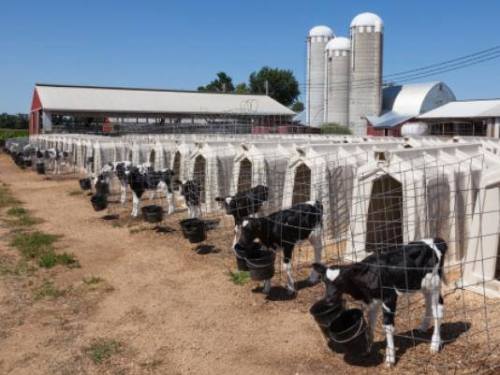In the unlikely event that anyone clicks on any of the links in my articles, you may have noticed that I don’t do a lot of linking to the traditional “animal rights” sites. While I agree with (much of) their message, I do not always agree with their arguments (or their tactics), and, because their arguments are often badly expressed, I do not usually find them to be valid references.
An example wandered across my Facebook feed today, and I felt compelled to comment. Understanding that I agree completely with the sentiment expressed by this video…I disagree with how it has chosen to convey its message.
The message is standard: “Dairy farming makes cows sad. Don’t eat dairy.” What puzzles me here is — where was this filmed? The cow and calf pictured are absolutely clean. The field they’re in is pristine, and, more suspicious, completely empty of other cows. One polite worker gently herds the calf away, lifts it carefully, and puts it in a clean truck? This is absolutely nothing like what you’d actually see in a factory farm. (I’m skipping the terror footage here — let’s look at a (more or less) ideal example. Here is Fair Oaks Farms, a multi-farm collective which gives public tours of some of its facilities — and which I have actually visited. Its publicly viewable facilities (video includes shots of normal birthing area, which is separate from Fair Oaks’ heavily advertised “birthing barn“) are a pretty good example of a very clean factory farm. The cows are in barns or small pens, not outdoor fields.) Here is a document from Ohio State University about calving, picturing the standard environment for a calving cow: a stall. Progressive Dairyman, an industry magazine, shows almost exclusively photos of stalled cattle. Only lucky, pastured cows get to give birth in a quiet field — this is certainly not a factory farm environment. (Is the point here that all farms are bad? Are all farms bad? What about those sanctuary farms where cows are kept in warm barns and not discarded when they get old? Small family farms? We’re edging perilously close to the “We must give up everything in order that animals can live free and unfettered” argument.)
Speaking of small family farms, where did Mercy for Animals get access to that cow and calf? Did they film collaboratively with a dairy farmer (this is obviously not undercover footage) while he separated a calf from its mother (why did they support him doing this?), or did they separate someone’s pet cow and calf temporarily, just for a commercial? Did they lie to a farmer and say they were filming for something else? Why did they need to film this anyway? It’s not like they don’t have already have much more relevant footage. They have plenty of terrifying shots, from real farms, on their YouTube channel, including this much better example of the same argument, which uses actual dairy farm footage.
This is NOT meant to be an attack on Mercy for Animals, which is just trying to do the best they can, and is actually doing a very good job getting a lot of multilingual (good for them!) videos out there spreading an important message. This is more a puzzled look at one of my least favorite trends in all pro-animal advertising (and many, many groups have made ads like this, not just MFA) — weird advertisements which trip over their own feet trying to make a point. All Mercy for Animals had to do was air, say, this footage, with a voiceover: “Is a piece of cheese worth this?” What’s with the unreal setup and scenery?
It occurs to me that probably this commercial has been “cleaned up” for wider public consumption, to try to reach the people who haven’t already been convinced that factory farming is bad, who don’t want to be convinced they should give up cheese, and who would normally stop watching the minute they see factory farm footage. What a sad thought on its own — we are being steered away from showing the truth, because people instantly stop listening. (Why?)



